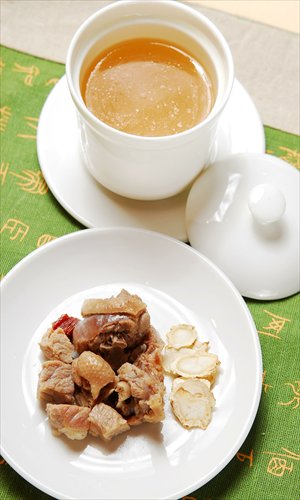In from the cold
Editor's note
The ancient Chinese created an agricultural solar system - still in use today - that is based upon their observation of crops, climate, astrology, and the study of animal and plant life cycles. The system guided farmers as to when to sow seeds and when to harvest them, and this system has now been in place for more than 2,000 years.Today, with advances in science and technology, agriculture depends less on this ancient wisdom. But this seasonal calendar still operates as a reference guide for gourmands to seek out the best times for seasonal delicacies and for health experts to plan nutritious diets.
In a single year, the system features 24 "solar terms," each lasting one day and occurring every two weeks. Each has its own name and characteristics. The Global Times is presenting a weekly series examining which foods and delicacies are best enjoyed during these periods, as well as tips on preserving general health.
Among the 24 solar terms, hanlu or "cold dew," is the first one that chronologically begins with the character for han, meaning "cold" in Chinese. This year, it falls on October 8. Just as the name suggests, the temperatures during this period are getting cooler all the time. The mildness of early autumn is now being replaced with the distinct chilliness of late fall.
During this period there is usually little rainfall. And although herbs and flowers begin to wither, cold, hardy plants such as chrysanthemums and osmanthus, are still in full bloom. They add more color to the season and fill the air with a rich, sweet fragrance. And these sights offer a great excuse to spend time outdoors, before the cold of winter keeps us indoors.
Just as they do other living beings, the changing seasons also affect the human body. The dryness of autumn sets the body "on fire" as internal heat accumulates during the summer. According to the principles of Traditional Chinese Medicine (TCM), the key to maintaining health at this time of the year is to clear away the dryness, help the body generate more fluids, and nourish the body's yin qualities. The Global Times has found a couple of easy-to-make recipes that help in all these tasks.

Duck soup with Chinese yam
Although they may appear complicated, soups are generally easy to make at home and all one needs is a little patience because they can take a while to cook. This soup is a gentle, nourishing tonic which is nutritiously beneficial for health. Chinese yam and duck meat effectively work together to rehydrate the body. Duck meat has a mild, cooling effect which helps offset the imbalance caused by excessive internal heat, while Chinese yam is believed to be helpful in gently nourishing qi, or the vital energy within the body, but without causing too much heat.
Ingredients: a clean duck about 1,000 grams in weight, 500 grams fresh Chinese yam, two tablespoons goji berry or wolfberry, five slices ginger, three sprigs spring onion, three tablespoons Chinese rice wine, 12 cups water, salt to taste.
Method:
* Chop the duck into chunky pieces and remove any excessive fat if necessary
* Peel off the skin of the Chinese yam and chop the flesh into chunks
* Put the duck pieces into a pot of soup stock together with the spring onion and ginger pieces
* Add water, bring to the boil and then simmer for 30 minutes
* Add the Chinese rice wine, put in the Chinese yam, and cook on a medium heat for a further 30 minutes
* Sprinkle in the wolfberries, boil again and simmer for another half an hour. If you prefer softer duck meat, cook for longer
* Season the soup with salt and serve hot

Braised chicken with chestnuts
During the autumn, it's easy to find a vendor in the city selling freshly roasted chestnuts. Apart from being a healthy snack, the chestnut is very versatile and can be included in many dishes including desserts. Unlike other nuts which are usually high in calories and fat, the main component of the chestnut is starch, and it is also a good source of minerals, vitamins and high-quality protein.
Ingredients: three chicken thighs with bones and skin, 200 grams shelled chestnuts, two slices ginger, two sprigs chopped spring onions, two tablespoons cooking oil, half tablespoon Chinese rice wine, one cup chicken stock, one teaspoon dark soy sauce, one teaspoon soy sauce, pinch of ground pepper, one teaspoon sugar, salt to taste.
Method:
* Wash the chicken thighs, pat dry and cut them into pieces
* Use a knife to remove the skin of the chestnuts and cut into small pieces
* Heat up a pan with one tablespoon of cooking oil, add the slices of ginger and chopped spring onion, and stir-fry them until fragrant
* Add the chicken pieces and stir-fry them on a medium heat until both sides slightly turn golden brown and remove them from the pan to a plate. Set aside for later use
* In the same pan, add another tablespoon of cooking oil and, when hot, add the chestnuts, and stir-fry for a few minutes
* Put the stir-fried chicken pieces back into the pan and stir-fry with the chestnuts
* Pour in the Chinese rice wine, and slowly add the chicken stock and the soy sauce
* Reduce the heat and let the sauce simmer, stir occasionally and add sugar
* Simmer till the liquid thickens and the chicken pieces soften, put them onto a plate and add ground pepper and salt to taste
* Serve hot with a bowl of rice and enjoy!